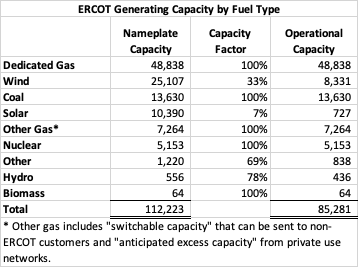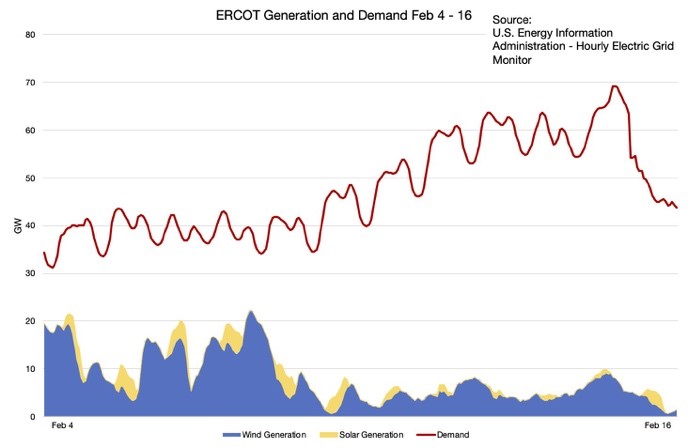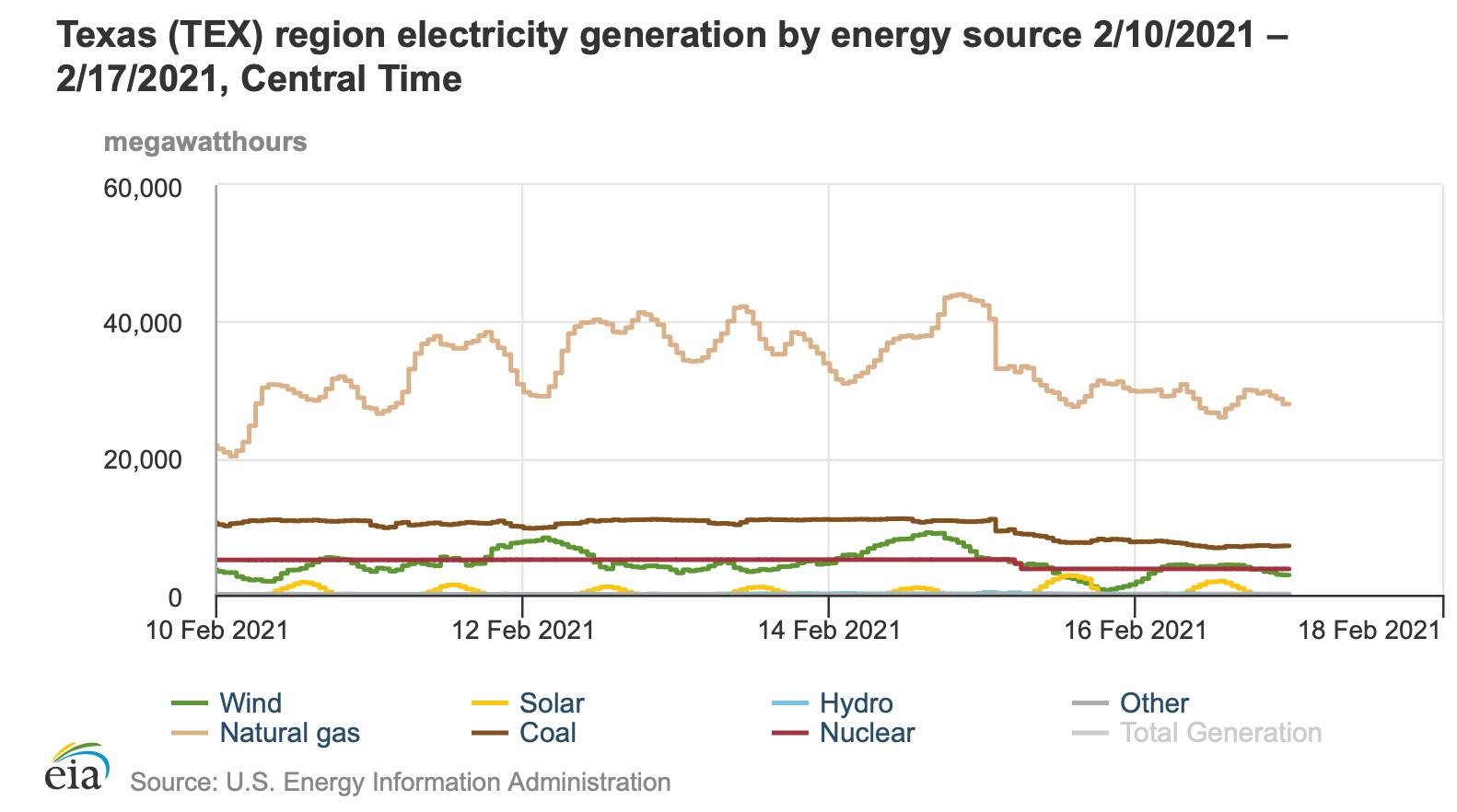How Wind Power Caused The Great Texas Blackout Of 2021-Part I
- The State of Texas is suffering from a catastrophic power grid failure that’s left 4.3 million homes without electricity, including 1.3 million homes in Houston, the country’s fourth-largest city.
- While talking heads, politicians, and the press are blaming fossil fuels and claiming that more renewables are the solution, hard data from the Energy Information Administration paints a very different picture.
- The generation failures that led to The Great Texas Blackout of 2021 began at 6 pm on Sunday. Wind power fell from 36% of nameplate capacity to 22% before midnight and plummeted to 3% of nameplate capacity by 8 pm on Monday.
- While power producers quickly ramped production to almost 90% of dedicated natural gas capacity, a combination of factors including shutdowns for scheduled maintenance and a statewide increase in natural gas demand began to overload safety systems and set-off a cascade of shutdowns.
- While similar overload-induced shutdowns followed suit in coal and nuclear plants, the domino effect began with ERCOT’s reckless reliance on unreliable wind power.
The State of Texas is currently suffering from a catastrophic power grid failure that’s left 1 in 3 customers without electricity for days. In my hometown of Houston, the fourth-largest city in the country, over 50% of households have suffered. I only lost power for 40 hours and consider myself fortunate. While it’s fair to say I’m irritated by the inconvenience, this article will focus on incontrovertible facts that prove ERCOT’s reckless reliance on unreliable wind power caused The Great Texas Blackout of 2021.
The ERCOT grid has 85,281 MW of operational generating capacity if no plants are offline for scheduled maintenance. Under the “Winter Fuel Types” tab of its Capacity, Demand and Reserves Report dated December 16, 2020, ERCOT described its operational generating capacity by fuel source as follows:
(Click on image to enlarge)

Since power producers frequently take gas-fired plants offline for scheduled maintenance in February and March when power demand is typically low, ERCOT’s systemwide generating capacity was less than 85 GW and its total power load was 59.6 GW at 9:00 am on Valentines Day. By 8:00 pm, power demand has surged to 68 GW (14%). Then hell froze over. Over the next 24 hours, statewide power production collapsed to 43.5 GW (36%) and millions of households were plunged into darkness in freezing weather conditions.
Earlier this week I read several tweets from Alex Epstein, author of “The Moral Case For Fossil Fuels,” that suggested unreliable wind power was a principal cause of the Texas blackouts. One of the more understandable images Mr. Epstein published shows how wind and solar collapsed completely as storm-related electricity demand surged.
(Click on image to enlarge)

While I think Mr. Epstein’s tweets and graphs offered a compelling visual depiction of the supply and demand dynamics that lead to the Great Texas Blackout of 2021, I’m a numbers guy who prefers time-stamped precision. So, I went to the US Energy Information Administration’s website and searched for hourly data on electricity production by fuel source in the State of Texas. The first treasure I found was this line graph that shows electricity generation by fuel source from 12:01 am on February 10th through 11:59 pm on February 16th.
(Click on image to enlarge)

The second and more important treasure was a downloadable spreadsheet file that contained the hourly data used to build the graph. An analysis of the hourly data shows:
- Wind power collapsing from 9 GW to 5.45 GW between 6 pm and 11:59 pm on the 14th with natural gas ramping from 41 GW to 43 GW during the same period.
- Wind power falling from 5.45 GW to 0.65 GW between 12:01 am and 8:00 pm on the 15th with natural gas spiking down from 40.4 GW to 33 GW between 2 am and 3 am as excess demand caused a cascade of safety events that took gas-fired plants offline.
- Coal power falling from 11.1 GW to 7.65 GW between 2:00 am and 3:00 pm on the 15th as storm-related demand overwhelmed generating capacity.
- Nuclear power falling from 5.1 GW to 3.8 GW at 7:00 am on the 15th as storm-related demand overwhelmed generating capacity.
- Wind power collapsing from 9 GW at 6:00 pm on the 14th to 5.45 GW at 11:59 pm;
- Natural gas ramping from 41 GW at 6:00 pm to 44 GW at 9:00 pm on the 14th, followed by a slow decline to 40.5 GW by 2:00 am on the 15th;
- Wind power falling from 5.45 GW at 12:01 am on the 15th to 649 MW at 8:00 pm;
- Natural gas spiking down from 40.5 GW at 2:00 am on the 15th to 33.1 GW at 3:00 am as collapsing wind power and storm-related power demand set off a cascade of safety events that took a third of the State’s gas-fired plants offline.
- Coal power falling from 11.1 GW to 7.65 GW between 2:00 am on the 15th and 3:00 pm as storm-related power demand overwhelmed generating capacity.
- Nuclear power falling from 5.1 GW 5:00 am on the 15th to 3.8 GW at 7:00 am as storm-related power demand overwhelmed generating capacity.
The following table summarizes the capacity losses of each class of generating assets.

The Great Texas Blackout of 2021 was a classic domino-effect chain reaction where unreliable wind power experienced a 40% failure before gas-fired power plants began to buckle under the strain of an unprecedented winter storm. There were plenty of failures by the time the dust settled, but ERCOT’s reckless reliance on unreliable wind power set up the chain of dominoes that brought untold suffering and death to Texas residents.
Conclusion
Over the last year, wind stocks like Vestas Wind Systems (VWDRY) TPI Composites (TPIC) Northland Power (NPIFF), American Superconductor (AMSC), and NextEra Energy (NEE) have soared on market expectations of unlimited future growth. As formal investigations into the root cause of The Great Texas Blackout of 2021 proceed to an inescapable conclusion that unreliable wind power is not suitable for use in advanced economies, I think market expectations are likely to turn and turn quickly. I won’t be surprised if the blowback from The Great Texas Blackout of 2021 rapidly bleeds over to other overvalued sectors that rely on renewables as the heart of their raison d’etre, including vehicle electrification.
>> Read Part II: How Wind Power Caused The Great Texas Blackout Of 2021-Part II
>> Related Article: Why Wind Power Transition Schemes Are Pipe Dreams
Disclosure: None




Excellent read.
Thanks for the info. However: to say 'wind power caused the blackout' is ludicrous. The utilities' RELIANCE on windpower is the problem. I bet houses with solar panels on their roofs have trouble when they're covered with snow too. Etc. Please make the case that the information supports and don't go down the rabbithole of 'alternate energy bad! fossil good!' - that just appeals to the lowest common denominator. Make your case more elegantly, please.
Wendell Brown, At 6:00 pm on Valentine's Day, wind power in Texas was 9,015 MW or 36% of nameplate capacity. By midnight on Valentine's Day, wind power had fallen to 5,450 MW or 22% of nameplate capacity. By noon on the 15th wind power had fallen to 3,185 MW or 16% of nameplate capacity. By 8:00 pm on the 15th wind power had fallen to 649 MW or 3% of nameplate capacity.
That catastrophic decline in wind power production coupled with rapidly rising demand triggered overload safety systems in all classes of power generation assets. Natural gas went down first, then coal, then nuclear.
Whether you like it or not, failures in wind kicked off a domino-effect chain reaction that damned near took down the entire ERCOT grid.
I'm sorry if my writing style does not live up to your standards, but I think the case has been made clearly and elegantly. If you disagree, please feel free to do your own research using EIA quality data sources and prove the argument you wish to make.
Sincere thanks for the response, John.
I'm not defending wind power. My question reflects my frustration in trying to understand why this wasn't anticipated before the utilities putting such a high degree of reliance on wind power. I don't know anything about utilities in Texas and would love to know how, in a state that I wouldn't think of as particularly 'green'-loving, this came to be.
After our long ugly political season, I guess I just want responsibility to be more of an issue. If you can share any links for my education I'd appreciate it.
Texas has good wind characteristics, favorable pricing and priorities for wind and solar power, and lots of wide-open space, so it's been a dream destination for wind developers for decades. ERCOT has no planning authority. It merely buys power from thousands of producers and sends it to hundreds of local utilities. Since wind power is treated as "more equal" than fossil-fueled power, wind producers can literally force fossil fuel plants to shut down. On a typical winter day, they expect wind to represent less than 1 GW of power supply. On Valentine's day that number was 9 GW and when the turbines started freezing all hell broke loose, or if you prefer hell froze over.
The public has been pretty tolerant of green idealism in the past. I don't expect that trend to continue after millions of us spent a long week freezing in the dark.
Great read.
Thanks for the kind words, James. I was a little concerned that I might be kicking a hornet's nest with this one.
I enjoyed it and your explanations in the comments section. Thanks.